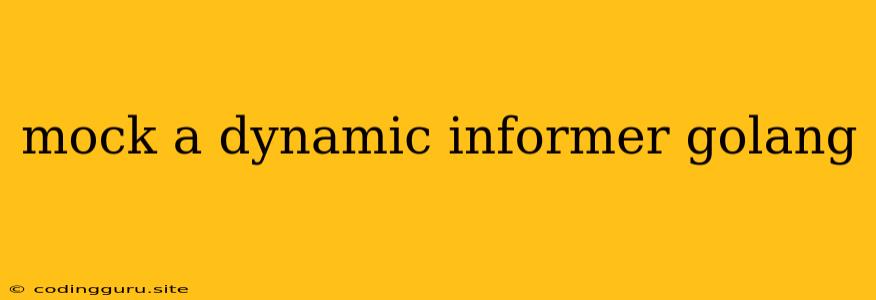Mocking Dynamic Informers in Golang: A Comprehensive Guide
Mocking is a crucial technique in unit testing, allowing you to isolate and test individual components of your code without relying on external dependencies. When dealing with dynamic informers in Go, which are often used to interact with external systems, mocking becomes essential for achieving comprehensive test coverage.
What are Dynamic Informers?
In Go, a dynamic informer is a component responsible for continuously updating data from an external source. This source could be a database, API endpoint, or any other system that provides dynamic information. Dynamic informers typically operate in the background, constantly monitoring for changes and updating the application state accordingly.
Why Mock Dynamic Informers?
Mocking dynamic informers during testing offers several advantages:
- Isolation: Mocking allows you to test your code in isolation, eliminating dependencies on external systems like databases or APIs. This makes your tests faster, more reliable, and less prone to failures due to external factors.
- Control: By mocking the informer, you can precisely control the data it returns, enabling you to test various scenarios, including edge cases and error conditions.
- Testability: Mocking allows you to test code that relies on the informer's functionality without requiring access to the actual external system. This is particularly useful when dealing with complex or sensitive data.
Mocking Techniques
There are several common techniques for mocking dynamic informers in Go:
1. Interface-based Mocking:
This is the most common and flexible approach. It involves defining an interface that encapsulates the functionality of the informer:
type Informer interface {
GetLatestData() (interface{}, error)
SubscribeToUpdates(callback func(interface{}))
UnsubscribeFromUpdates(callback func(interface{}))
}
You can then create a mock implementation of this interface for testing:
type MockInformer struct {
LatestData interface{}
Updates chan interface{}
}
func (m *MockInformer) GetLatestData() (interface{}, error) {
return m.LatestData, nil
}
func (m *MockInformer) SubscribeToUpdates(callback func(interface{})) {
m.Updates = make(chan interface{})
go func() {
for update := range m.Updates {
callback(update)
}
}()
}
func (m *MockInformer) UnsubscribeFromUpdates(callback func(interface{})) {
close(m.Updates)
}
This mock informer provides the necessary functionality for your tests, allowing you to control the data returned and the updates triggered.
2. Using Mocking Libraries:
Libraries like "github.com/stretchr/testify/mock" or "github.com/golang/mock" provide powerful tools for creating mocks. These libraries simplify the process of defining mock interfaces, generating mock implementations, and setting up expectations.
3. Manual Mocking:
For simple scenarios, you can manually create mock implementations without using interfaces or libraries. This involves creating a struct that mimics the behavior of the real informer.
Example: Mocking a Dynamic Informer for Stock Prices
Let's illustrate how to mock a dynamic informer using the interface-based approach. Consider a scenario where you have a component that retrieves and displays stock prices from an external API. You want to test this component in isolation without actually making calls to the API.
1. Define the Informer Interface:
type StockPriceInformer interface {
GetLatestPrice(ticker string) (float64, error)
SubscribeToPriceUpdates(ticker string, callback func(float64))
UnsubscribeFromPriceUpdates(ticker string, callback func(float64))
}
2. Create the Mock Implementation:
type MockStockPriceInformer struct {
LatestPrices map[string]float64
PriceUpdates map[string]chan float64
}
func (m *MockStockPriceInformer) GetLatestPrice(ticker string) (float64, error) {
price, ok := m.LatestPrices[ticker]
if !ok {
return 0, fmt.Errorf("ticker not found: %s", ticker)
}
return price, nil
}
func (m *MockStockPriceInformer) SubscribeToPriceUpdates(ticker string, callback func(float64)) {
if _, ok := m.PriceUpdates[ticker]; !ok {
m.PriceUpdates[ticker] = make(chan float64)
}
go func() {
for update := range m.PriceUpdates[ticker] {
callback(update)
}
}()
}
func (m *MockStockPriceInformer) UnsubscribeFromPriceUpdates(ticker string, callback func(float64)) {
close(m.PriceUpdates[ticker])
}
3. Utilize the Mock in Your Test:
func TestStockPriceDisplay(t *testing.T) {
// Create the mock informer
mockInformer := &MockStockPriceInformer{
LatestPrices: map[string]float64{"AAPL": 170.00, "GOOG": 2800.00},
PriceUpdates: map[string]chan float64{},
}
// Initialize the component that uses the informer
priceDisplay := NewStockPriceDisplay(mockInformer)
// Assert the initial price display
assert.Equal(t, 170.00, priceDisplay.GetLatestPrice("AAPL"))
// Simulate a price update
mockInformer.PriceUpdates["AAPL"] <- 175.00
// Assert the updated price
assert.Equal(t, 175.00, priceDisplay.GetLatestPrice("AAPL"))
}
In this example, we create a mock MockStockPriceInformer that implements the StockPriceInformer interface. We control the initial prices and simulate updates using channels. We then use the mock informer in our TestStockPriceDisplay function to verify the behavior of the StockPriceDisplay component.
Conclusion
Mocking dynamic informers is essential for creating robust and comprehensive unit tests in Go. By isolating your code and controlling data flow, you can ensure reliable testing and improve the overall quality of your application. The interface-based approach, combined with mocking libraries, offers a powerful and flexible way to implement mocking for dynamic informers, enhancing your testing capabilities significantly.
